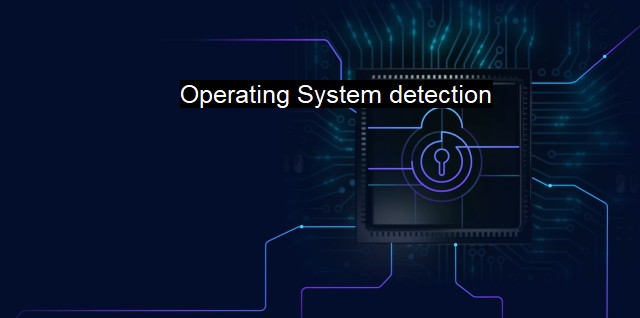What is Operating System detection?
The Importance of Operating System Detection in Cybersecurity: Identifying Vulnerabilities and Risks for Enhanced Protection
Operating System detection refers to the process where a system or a piece of software identifies the specifics of the operating system of a computer or network. Operating System (OS) detection plays a critical role by allowing the security tools to pinpoint the specifications of the system to tailor protection measures that meet each unique needs and vulnerabilities.As its name suggests, an operating system refers to the software that, under almost all circumstances, utilizes the computer hardware to provide common services for other software pieces. Thus, each OS has a differential structure and properties from another. For instance, the architecture of Microsoft Windows differs from that of Linux or Mac OS. Each has its own set of vulnerabilities, with some exclusive to a particular type of OS due to its distinct design and functionalities.
Operating System detection is achieved via sophisticated techniques that interact pertinently with a system to provoke responses, revealing the nature and type of the operating system running on a computer. The responses that are obtained from this specific interaction help the program determine what type of operating system it is dealing with.
Nmap, a notable network scanning tool, uses active stack fingerprinting for OS detection. This technique provokes responses in the system by sending a series of designed TCP and UDP packets that subsequently elicit responses that betray the specifics of the operating system. Invoking certain specific instructions causes different flags to be set in response packets; these are carefully observed, leading to an accurate deduction about the operating system's nature.
In the broader arena of cybersecurity and antivirus, the significance of OS detection is paramount. When a cybersecurity software or antivirus is aware of the type of OS employed in the system, it can leverage more precisely morphe its defense and scanning mechanisms. Windows systems are highly susceptible to file-sharing vulnerabilities, and a vast number of Windows-exclusive malicious payloads exist. Hence, for systems identified as running Windows, security tools can optimize their protocols for these specific vulnerabilities and threats.
Once the specifics of the OS are known, the security tools can focus their efforts on monitoring activities related to the identified OS’s common vulnerabilities. The efficiency in identifying threats dramatically increases as there is a marked decrement in the noise from look-alike intrusions that are unrelated to the nature of the OS known.
Hackers also use OS detection for sinister reasons. They employ this tool to determine what type of operating system is run by the target. Using that information, they can tailor their attacks to exploit the specific vulnerabilities of that OS. Playfully called 'safe cracking' in the hacking parlance, this targeted exploitation inclines the success probability favorably towards the attacker. Knowing the defenses empowers hackers to manoeuvre proficiently within the shadows, striking surgically at weak spots while eluding the defense mechanisms in play.
In the field of penetration testing - ethical hacking to examine cyber defenses - OS detection is employed. Identifying the system specifics allows testers to gauge how good the existing cybersecurity systems are, simulating highly targeted attacks mimicking those of cyber attackers.
Operating system detection is a powerful tool in the cybersecurity landscape with profound implications. From enhancing security by enabling tailored defense measures to being a sharp double-edged sword that hackers exploit for forced unauthorized intrusions, operating system detection remains at the very heart of the cyber chess match between cybersecurity experts and hackers. Thus, a thorough understanding of this technology underscores judicious application and counteractive developmental programs, leading to a more formidable security net protecting against cyber attacks.

Operating System detection FAQs
What is operating system detection?
Operating system detection is the process of determining the type and version of operating system that a computer or device is running. This information is important in cybersecurity, as it helps antivirus programs and other security tools to identify vulnerabilities and threats that are specific to a particular operating system.Why is operating system detection important in cybersecurity?
Operating system detection is important in cybersecurity because different operating systems have different vulnerabilities and security risks. By detecting the operating system, antivirus programs and other security tools can better protect the device against potential threats that are specific to that particular operating system.What are some common techniques for operating system detection in cybersecurity?
Some common techniques for operating system detection in cybersecurity include analyzing the system's network traffic, examining the system's file and directory structure, checking the system's registry settings, and using various software tools designed specifically for operating system detection.What are the benefits of using operating system detection in antivirus software?
Using operating system detection in antivirus software can provide several benefits, including improved accuracy in detecting and blocking malware that is specific to a particular operating system, faster response times in detecting and addressing emerging security threats, and more efficient use of system resources, since the antivirus software can be tailored to the specific operating system and hardware configuration of the user's device.| | A | | | B | | | C | | | D | | | E | | | F | | | G | | | H | | | I | | | J | | | K | | | L | | | M | |
| | N | | | O | | | P | | | Q | | | R | | | S | | | T | | | U | | | V | | | W | | | X | | | Y | | | Z | |
| | 1 | | | 2 | | | 3 | | | 4 | | | 7 | | | 8 | | |||||||